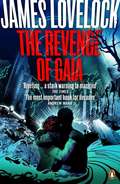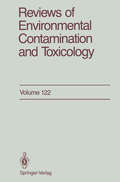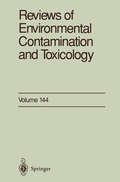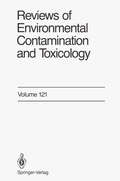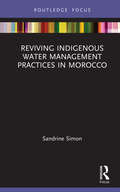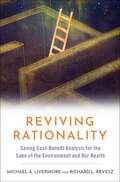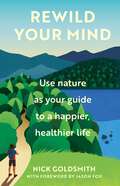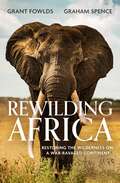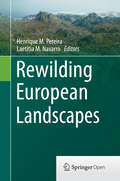- Table View
- List View
The Revenge of Gaia: Why the Earth is Fighting Back and How We Can Still Save Humanity (Penguin Celebrations Ser.)
by James LovelockFor millennia, humankind has exploited the Earth without counting the cost. Now, as the world warms and weather patterns dramatically change, the Earth is beginning to fight back. James Lovelock, one of the giants of environmental thinking, argues passionately and poetically that, although global warming is now inevitable, we are not yet too late to save at least part of human civilization. This short book, written at the age of eighty-six after a lifetime engaged in the science of the earth, is his testament.
Review and Integration of Biosphere-Atmosphere Modelling of Reactive Trace Gases and Volatile Aerosols
by Raia-Silva Massad Benjamin LoubetWhen considering biosphere–atmosphere exchange of trace gases and volatile aerosols, significant advances have been made both from an experimental and modelling point of view and on several scales. This was particularly stimulated by the availability of new datasets generated from improvements in analytical methods and flux measurement techniques. Recent research advances allow us, not only to identify major mechanisms and factors affecting the exchanges between the biosphere and the atmosphere, but also to recognize several gaps in the methodologies used in accounting for emissions and deposition in landscape and global scale models. This work aims at (i) reviewing exchange processes and modelling schemes, parameterisations and datasets, (ii) presenting a common conceptual framework to model soil-vegetation-atmosphere exchange of reactive trace gases and aerosols accounting for in-canopy transfer chemical interactions and (iii) discussing the key elements of the agreed framework.
Reviews of Environmental Contamination and Toxicology: Continuation of Residue Reviews (Reviews of Environmental Contamination and Toxicology #104)
by US Environmental Protection Agency, Office of Drinking WaterHealth AdvisoriesGlobal attention in scientific, industrial, and governmental commUnItIes to traces of toxic chemicals in foodstuffs and in both abiotic and biotic environ ments has justified the present triumvirate of specialized publications in this field: comprehensive reviews, rapidly published progress reports, and archival documentations. These three publications are integrated and scheduled to pro vide in international communication the coherency essential for nonduplicative and current progress in a field as dynamic and complex as environmental con tamination and toxicology. Until now there has been no journal or other publica tion series reserved exclusively for the diversified literature on "toxic" chemicals in our foods, our feeds, our geographical surroundings, our domestic animals, our wildlife, and ourselves. Around the world immense efforts and many talents have been mobilized to technical and other evaluations of natures, locales, magnitudes, fates, and toxicology of the persisting residues of these chemicals loosed upon the world. Among the sequelae of this broad new emphasis has been an inescapable need for an articulated set of authoritative publications where one could expect to find the latest important world literature produced by this emerging area of science together with documentation of pertinent ancil lary legislation.
Reviews of Environmental Contamination and Toxicology: Continuation of Residue Reviews (Reviews of Environmental Contamination and Toxicology #151)
by George W. WareInternational concern in scientific, industrial, and governmental communi ties over traces of xenobiotics in foods and in both abiotic and biotic envi ronments has justified the present triumvirate of specialized publications in this field: comprehensive reviews, rapidly published research papers and progress reports, and archival documentations. These three international publications are integrated and scheduled to provide the coherency essential for nonduplicative and current progress in a field as dynamic and complex as environmental contamination and toxicology. This series is reserved ex clusively for the diversified literature on "toxic" chemicals in our food, our feeds, our homes, recreational and working surroundings, our domestic animals, our wildlife and ourselves. Tremendous efforts worldwide have been mobilized to evaluate the nature, presence, magnitude, fate, and toxi cology of the chemicals loosed upon the earth. Among the sequelae of this broad new emphasis is an undeniable need for an articulated set of authoritative publications, where one can find the latest important world literature produced by these emerging areas of science together with docu mentation of pertinent ancillary legislation. Research directors and legislative or administrative advisers do not have the time to scan the escalating number of technical publications that may contain articles important to current responsibility. Rather, these individu als need the background provided by detailed reviews and the assurance that the latest information is made available to them, all with minimal literature searching.
Reviews of Environmental Contamination and Toxicology: Continuation of Residue Reviews (Reviews of Environmental Contamination and Toxicology #152)
by George W. WareInternational concern in scientific, industrial, and governmental communities of xenobiotics in foods and in both abiotic and biotic environments over traces has justified the present triumvirate of specialized publications in this field: comprehensive reviews, rapidly published research papers and progress reports, and archival documentations. These three international publications are inte grated and scheduled to provide the coherency essential for nonduplicative and current progress in a field as dynamic and complex as environmental contamina tion and toxicology. This series is reserved exclusively for the diversified litera ture on "toxic" chemicals in our food, our feeds, our homes, recreational and working surroundings, our domestic animals, our wildlife and ourselves. Tre mendous efforts worldwide have been mobilized to evaluate the nature, pres ence, magnitude, fate, and toxicology of the chemicals loosed upon the earth. Among the sequelae of this broad new emphasis is an undeniable need for an articulated set of authoritative publications, where one can find the latest impor tant world literature produced by these emerging areas of science together with documentation of pertinent ancillary legislation. Research directors and legislative or administrative advisers do not have the time to scan the escalating number of technical publications that may contain articles important to current responsibility. Rather, these individuals need the background provided by detailed reviews and the assurance that the latest infor mation is made available to them, all with minimal literature searching.
Reviews of Environmental Contamination and Toxicology: Continuation of Residue Reviews (Reviews of Environmental Contamination and Toxicology #153)
by George W. WareReviews of Environmental Contamination and Toxicology provides detailed review articles concerned with aspects of chemical contaminants, including pesticides, in the total environment with toxicological considerations and consequences. RAJ GROVER, JEFFREY D. WOLT, ALLAN J. CESSNA, AND H. BRUNO SCHIEFER: Environmental Fate of Trifluralin JEFFREY D. WOLT: Environmental Fate of Ethalfluralin ALFONSO V. BOTELLO, SUSANA VILLANUEVA F. AND GILBERTO DIAZ G.: Petroleum Pollution in the Gulf of Mexico and Caribbean Sea
Reviews of Environmental Contamination and Toxicology: Continuation of Residue Reviews (Reviews of Environmental Contamination and Toxicology #122)
by George W. WareReviews of Environmental Contamination and Toxicology publishes authoritative reviews on the occurrence, effects, and fate of pesticide residues and other environmental contaminants. It will keep you informed of the latest significant issues by providing in-depth information in the areas of analytical chemistry, agricultural microbiology, biochemistry, human and veterinary medicine, toxicology, and food technology.
Reviews of Environmental Contamination and Toxicology: Continuation of Residue Reviews (Reviews of Environmental Contamination and Toxicology #105)
by George W. WareReviews of Environmental Contamination and Toxicology contains timely review articles concerned with all aspects of chemical contaminants (including pesticides) in the total environment, including toxicological considerations and consequences. It provides concise, critical reviews of advances, philosophy, and significant areas of accomplished or needed endeavor in the total field of residues of these and other foreign chemicals in any segment of the environment, as well as toxicological implications.
Reviews of Environmental Contamination and Toxicology: Continuation of Residue Reviews (Reviews of Environmental Contamination and Toxicology #110)
by George W. WareGlobal attention in scientific, industrial, and governmental commumtIes to traces of toxic chemicals in foodstuffs and in both abiotic. and biotic environ ments has justified the present triumvirate of specialized publications in this field: comprehensive reviews, rapidly published progress reports, and archival documentations. These three publications are integrated and scheduled to pro vide in international communication the coherency essential for nonduplicative and current progress in a field as dynamic and complex as environmental con tamination and toxicology. Until now there has been no journal or other publica tion series reserved exclusively for the diversified literature on "toxic" chemicals in our foods, our feeds, our geographical surroundings, our domestic animals, our wildlife, and ourselves. Around the world immense efforts and many talents have been mobilized to technical and other evaluations of natures, locales, magnitudes, fates, and toxicology of the persisting residues of these chemicals loosed upon the world. Among the sequelae of this broad new emphasis has been an inescapable need for an articulated set of authoritative publications where one could expect to find the latest important world literature produced by this emerging area of science together with documentation of pertinent ancil lary legislation.
Reviews of Environmental Contamination and Toxicology: Continuation of Residue Reviews (Reviews of Environmental Contamination and Toxicology #144)
by George W. WareInternational concern in scientific, industrial, and governmental communi ties over traces of xenobiotics in foods and in both abiotic and biotic envi ronments has justified the present triumvirate of specialized publications in this field: comprehensive reviews, rapidly published research papers and progress reports, and archival documentations. These three international pUblications are integrated and scheduled to provide the coherency essential for nonduplicative and current progress in a field as dynamic and complex as environmental contamination and toxicology. This series is reserved ex clusively for the diversified literature on ''toxic'' chemicals in our food, our feeds, our homes, recreational and working surroundings, our domestic animals, our wildlife and ourselves. Tremendous efforts worldwide have been mobilized to evaluate the nature, presence, magnitude, fate, and toxi cology of the chemicals loosed upon the earth. Among the sequelae of this broad new emphasis is an undeniable need for an articulated set of authoritative publications, where one can find the latest important world literature produced by these emerging areas of science together with docu mentation of pertinent ancillary legislation. Research directors and legislative or administrative advisers do not have the time to scan the escalating number of technical publications that may contain articles important to current responsibility. Rather, these individu als need the background provided by detailed reviews and the assurance that the latest information is made available to them, all with minimal literature searching. Similarly.
Reviews of Environmental Contamination and Toxicology: Continuation of Residue Reviews (Reviews of Environmental Contamination and Toxicology #121)
by George W. WareReviews of Environmental Contamination and Toxicology publishes authoritative reviews on the occurrence, effects, and fate of pesticide residues and other environmental contaminants. It will keep you informed of the latest significant issues by providing in-depth information in the areas of analytical chemistry, agricultural microbiology, biochemistry, human and veterinary medicine, toxicology, and food technology.
Reviews of Environmental Contamination and Toxicology: Continuation of Residue Reviews (Reviews of Environmental Contamination and Toxicology #168)
by George W. WareInternational concern in scientific, industrial, and governmental commumtIes over traces of xenobiotics in foods and in both abiotic and biotic environments has justified the present triumvirate of specialized publications in this field: comprehensive reviews, rapidly published research papers and progress reports, and archival documentations. These three international publications are inte grated and scheduled to provide the coherency essential for nonduplicative and current progress in a field as dynamic and complex as environmental contamina tion and toxicology. This series is reserved exclusively for the diversified litera ture on "toxic" chemicals in our food, our feeds, our homes, recreational and working surroundings, our domestic animals, our wildlife and ourselves. Tre mendous efforts worldwide have been mobilized to evaluate the nature, pres ence, magnitude, fate, and toxicology of the chemicals loosed upon the earth. Among the sequelae of this broad new emphasis is an undeniable need for an articulated set of authoritative publications, where one can find the latest impor tant world literature produced by these emerging areas of science together with documentation of pertinent ancillary legislation. Research directors and legislative or administrative advisers do not have the time to scan the escalating number of technical publications that may contain articles important to current responsibility. Rather, these individuals need the background provided by detailed reviews and the assurance that the latest infor mation is made available to them, all with minimal literature searching.
Reviews of Environmental Contamination and Toxicology: Continuation Of Residue Reviews (Reviews of Environmental Contamination and Toxicology #108)
by George W. WareGlobal attention in scientific, industrial, and governmental communities to traces of toxic chemicals in foodstuffs and in both abiotic and biotic environ ments has justified the present triumvirate of specialized publications in this field: comprehensive reviews, rapidly published progress reports, and archival documentations. These three publications are integrated and scheduled to pro vide in international communication the coherency essential for nonduplicative and current progress in a field as dynamic and complex as environmental con tamination and toxicology. Until now there has been no journal or other publica tion series reserved exclusively for the diversified literature on "toxic" chemicals in our foods, our feeds, our geographical surroundings, our domestic animals, our wildlife, and ourselves. Around the world immense efforts and many talents have been mobilized to technical and other evaluations of natures, locales, magnitudes, fates, and toxicology of the persisting residues of these chemicals loosed upon the world. Among the sequelae of this broad new emphasis has been an inescapable need for an articulated set of authoritative publications where one could expect to find the latest important world literature produced by this emerging area of science together with documentation of pertinent ancil lary legislation.
Revitalizing Urban Waterway Communities: Streams of Environmental Justice (Earthscan Studies in Water Resource Management)
by Richard Smardon Sharon Moran April Karen BaptisteThe revitalizing and restoration of rivers, creeks and streams is a major focus of urban conservation activity throughout North America and Europe. This book presents models and examples for organizing multiple stakeholders for purposes of waterway revitalization—if not restoration—within a context of fairness and environmental justice. After decades of neglect and misuse the challenge of cleaning up urban rivers and streams is shown to be complex and truly daunting. Urban river cleanup typically involves multiple agendas and stakeholders, as well as complicated technical issues. It is also often the situation that the most affected have the least voice in what happens. The authors present social process models for maximum inclusion of various stakeholders in decision-making for urban waterway regeneration. A range of examples is presented, drawn principally from North America and Europe.
Revitalizing Urban Waterway Communities: Streams of Environmental Justice (Earthscan Studies in Water Resource Management)
by Richard Smardon Sharon Moran April Karen BaptisteThe revitalizing and restoration of rivers, creeks and streams is a major focus of urban conservation activity throughout North America and Europe. This book presents models and examples for organizing multiple stakeholders for purposes of waterway revitalization—if not restoration—within a context of fairness and environmental justice. After decades of neglect and misuse the challenge of cleaning up urban rivers and streams is shown to be complex and truly daunting. Urban river cleanup typically involves multiple agendas and stakeholders, as well as complicated technical issues. It is also often the situation that the most affected have the least voice in what happens. The authors present social process models for maximum inclusion of various stakeholders in decision-making for urban waterway regeneration. A range of examples is presented, drawn principally from North America and Europe.
Reviving Aleppo: Urban, Legal and Digital Approaches for Post-War Recovery (Cities, Heritage and Transformation)
by Fabian Thiel Rahaf OrabiThis book provides indispensable and interdisciplinary insights into the revitalization and redevelopment of urban centers in war-stricken conflict regions, such as Aleppo in northern Syria. This contribution explores innovative, cutting-edge toolkits for academicians, digital building technologists, engineers, architects, archeologists, (urban) planners, land policy advisors and legal scholars. The compendium not only analyzes strategies and shortcomings of implementation guidelines drawn by donor organizations, development agencies and political actors, but also explores possibilities for initiating functioning and sustainably resilient networks that can establish capacity-building platforms for recovery and reconstruction. Although the work focuses on a city in Syria, it holds lessons, toolkits and instruments for other areas in the region and beyond.
Reviving Indigenous Water Management Practices in Morocco: Alternative Pathways to Sustainable Development (Earthscan Studies in Water Resource Management)
by Sandrine SimonThis book demonstrates how Morocco and other semi-arid countries can find solutions to water scarcity by rediscovering traditional methods of water resource management. The book begins by examining indigenous water heritage, considering the contribution of Islam and the mixed influences of Greek and Roman, Middle Eastern, Andalusian and Berber cultures. It then provides a thorough examination of resource management practices in Morocco throughout history, tracing the changing patterns from the instillation of agrarian capitalism in the 19th century, through the Protectorate years (1912–1956), to the 21st century. The book explains how reviving and modernizing traditional methods of water management could provide simple, accessible, and successful methods for addressing 21st century challenges, such as water scarcity and climate change. The work concludes by highlighting how these indigenous practices might be used to provide real-world practical solutions for improving water governance and therefore developing sustainable water management practices. Reviving Indigenous Water Management Practices in Morocco will be of great interest to students and scholars interested in water resource management, indigenous peoples, traditional knowledge, and sustainable development.
Reviving Indigenous Water Management Practices in Morocco: Alternative Pathways to Sustainable Development (Earthscan Studies in Water Resource Management)
by Sandrine SimonThis book demonstrates how Morocco and other semi-arid countries can find solutions to water scarcity by rediscovering traditional methods of water resource management. The book begins by examining indigenous water heritage, considering the contribution of Islam and the mixed influences of Greek and Roman, Middle Eastern, Andalusian and Berber cultures. It then provides a thorough examination of resource management practices in Morocco throughout history, tracing the changing patterns from the instillation of agrarian capitalism in the 19th century, through the Protectorate years (1912–1956), to the 21st century. The book explains how reviving and modernizing traditional methods of water management could provide simple, accessible, and successful methods for addressing 21st century challenges, such as water scarcity and climate change. The work concludes by highlighting how these indigenous practices might be used to provide real-world practical solutions for improving water governance and therefore developing sustainable water management practices. Reviving Indigenous Water Management Practices in Morocco will be of great interest to students and scholars interested in water resource management, indigenous peoples, traditional knowledge, and sustainable development.
Reviving Rationality: Saving Cost-Benefit Analysis for the Sake of the Environment and Our Health
by Michael A. Livermore Richard L. ReveszFor decades, administrations of both political parties have used cost-benefit analysis to evaluate and improve federal policy in a variety of areas, including health and the environment. Today, this model is under grave threat. In Reviving Rationality, Michael Livermore and Richard Revesz explain how Donald Trump has destabilized the decades-long bipartisan consensus that federal agencies must base their decisions on evidence, expertise, and analysis. Administrative agencies are charged by law with protecting values like stable financial markets and clean air. Their decisions often have profound consequences, affecting everything from the safety of workplaces to access to the dream of home ownership. Under the Trump administration, agencies have been hampered in their ability to advance these missions by the conflicting ideological whims of a changing cast of political appointees and overwhelming pressure from well-connected interest groups. Inconvenient evidence has been ignored, experts have been sidelined, and analysis has been used to obscure facts, rather than inform the public. The results are grim: incoherent policy, social division, defeats in court, a demoralized federal workforce, and a loss of faith in government's ability to respond to pressing problems. This experiment in abandoning the norms of good governance has been a disaster. Reviving Rationality explains how and why our government has abandoned rationality in recent years, and why it is so important for future administrations to restore rigorous cost-benefit analysis if we are to return to a policymaking approach that effectively tackles the most pressing problems of our era.
Reviving Rationality: Saving Cost-Benefit Analysis for the Sake of the Environment and Our Health
by Richard L. Revesz Michael A. LivermoreFor decades, administrations of both political parties have used cost-benefit analysis to evaluate and improve federal policy in a variety of areas, including health and the environment. Today, this model is under grave threat. In Reviving Rationality, Michael Livermore and Richard Revesz explain how Donald Trump has destabilized the decades-long bipartisan consensus that federal agencies must base their decisions on evidence, expertise, and analysis. Administrative agencies are charged by law with protecting values like stable financial markets and clean air. Their decisions often have profound consequences, affecting everything from the safety of workplaces to access to the dream of home ownership. Under the Trump administration, agencies have been hampered in their ability to advance these missions by the conflicting ideological whims of a changing cast of political appointees and overwhelming pressure from well-connected interest groups. Inconvenient evidence has been ignored, experts have been sidelined, and analysis has been used to obscure facts, rather than inform the public. The results are grim: incoherent policy, social division, defeats in court, a demoralized federal workforce, and a loss of faith in government's ability to respond to pressing problems. This experiment in abandoning the norms of good governance has been a disaster. Reviving Rationality explains how and why our government has abandoned rationality in recent years, and why it is so important for future administrations to restore rigorous cost-benefit analysis if we are to return to a policymaking approach that effectively tackles the most pressing problems of our era.
Rewild Your Mind: Use nature as your guide to a happier, healthier life
by Nick GoldsmithRewild Your Mind shows you how to connect with nature to be happier, healthier and more at peace with the world around you.Packed with wilderness skills and traditional crafts – from fixing a hammock in the woods and foraging for hedgerow medicine to finding moments of 'wild' in the everyday – this unique book enables readers to boost their wellbeing through getting outside. It is an invitation to reset, recharge and 'rewild' yourself.Weaved through the book is Nick Goldsmith's personal story of using nature to aid his recovery from PTSD. After several tours serving as a Royal Marine Commando in Afghanistan, Nick was left in a dark and desperate place. He tried conventional therapies but found true solace amongst nature, and now enables others to do the same.
Rewilding: India’s Experiments in Saving Nature
by Bahar DuttWe live in a time of serious environmental catastrophes. Every year we lose thousands of species, even as others slip deeper into danger. The extinction crisis is well known; what is not are stories of people trying to turn the tide. In Rewilding, environmental journalist Bahar Dutt documents stories of hope for India's natural world. She meets people who are trying to conserve species not just by replenishing their dwindling numbers, but also by restoring their habitats in the wild. This means going to great lengths, from airlifting corals from coast to coast, to going undercover as a spy to check the availability of toxic drugs that wiped out a bird. In the process, Bahar learns that though it may not offer easy answers, rewilding can offer great rewards. And that news about the environment doesn't always have to be bad.
Rewilding: The Radical New Science of Ecological Recovery (Hot Science #14)
by Paul Jepson Cain BlytheRewilding is the first popular book on the ground-breaking science behind the restoration of wild nature. As ecologists Paul Jepson and Cain Blythe show, rewilding is a new and progressive approach to conservation, blending radical scientific insights with practical innovations to revive ecological processes, benefiting people as well as nature. Its goal is to restore lost interactions between animals, plants and natural disturbance that are the essence of thriving ecosystems. With its sense of hope and purpose, rewilding is breathing new life into the conservation movement, and enabling a growing number of people – even urban-dwellers – to enjoy thrilling wildlife experiences previously accessible only in remote wilderness reserves. ‘De-domesticated’ horses galloping across a Dutch ‘Serengeti’; beavers creating wetlands in the British countryside; giant tortoises restoring the wildlife of the Mauritian islands; perhaps one day even rhinos roaming the Australian outback – rewilding is full of exciting and inspirational possibilities.
Rewilding Africa: Restoring the Wilderness on a War-ravaged Continent
by Grant Fowlds Graham SpenceConservationist Grant Fowlds lives to save and protect Africa's rhinos, elephants and other iconic wildlife, to preserve their habitats, to increase their range and bring back the animals where they have been decimated by decades of war, as in Angola, Mozambique and the Democratic Republic of the Congo. This vivid account of his work tells of a fellow conservationist tragically killed by the elephants he was seeking to save and a face-off with poachers, impoverished rural people exploited by rapacious local businessmen. Fowlds describes the impact of the Covid pandemic on conservation efforts, the vital wildlife tourism that sustains these and rural communities; and tells of conservationists' efforts to support people through the crisis. Lockdowns may have brought a welcome lull in rhino and other poaching, but also brought precious tourism to a standstill. He shows how the pandemic has highlighted the danger to the world of the illicit trade in endangered wildlife, some of it sold in 'wet markets', where pathogens incubate and spread. He describes a restoration project of apartheid-era, ex-South African soldiers seeking to make reparations in Angola, engulfed for many years in a profoundly damaging civil war, which drew in outside forces, from Cuba, Russia and South Africa, with a catastophic impact on that country's wildlife. Those who fund conservation, whether in the US, Zambia or South Africa itself, are of vital importance to efforts to conserve and rewild: some supposed angel-investors turn out to be not what they had appeared, some are thwarted in their efforts, but others are open-hearted and generous in the extreme, which makes their sudden, unexpected death an even greater tragedy. A passionate desire to conserve nature has also brought conservationists previously active in far-off Venezuela to southern Africa. Fowlds describes fraught meetings to negotiate the coexistence of wildlife and rural communities. There are vivid accounts of the skilled and dangerous work of using helicopters to keep wildebeest, carrying disease, and cattle apart, and to keep elephants from damaging communal land and eating crops such as sugar cane. He tells of a project to restore Africa's previously vast herds of elephants, particularly the famed 'tuskers', with their unusually large tusks, once prized and hunted almost to extinction. The range expansion that this entails is key to enabling Africa's iconic wildlife to survive, to preserving its wilderness and, in turn, helping humankind to survive.There is a heartening look at conservation efforts in Mozambique, a country scarred by years of war, which are starting to bear fruit, though just as a new ISIS insurgency creates havoc in the north of the country. What will humanity's relationship with nature be post-pandemic? Will we have begun to learn that by conserving iconic wildlife and their habitats we help to preserve and restore precious pockets of wilderness, which are so vital not only the survival of wildlife, but to our own survival on our one precious planet.
Rewilding European Landscapes
by Henrique M. Pereira Laetitia M. NavarroSome European lands have been progressively alleviated of human pressures, particularly traditional agriculture in remote areas. This book proposes that this land abandonment can be seen as an opportunity to restore natural ecosystems via rewilding. We define rewilding as the passive management of ecological successions having in mind the long-term goal of restoring natural ecosystem processes. The book aims at introducing the concept of rewilding to scientists, students and practitioners. The first part presents the theory of rewilding in the European context. The second part of the book directly addresses the link between rewilding, biodiversity, and habitats. The third and last part is dedicated to practical aspects of the implementation of rewilding as a land management option. We believe that this book will both set the basis for future research on rewilding and help practitioners think about how rewilding can take place in areas under their management.
